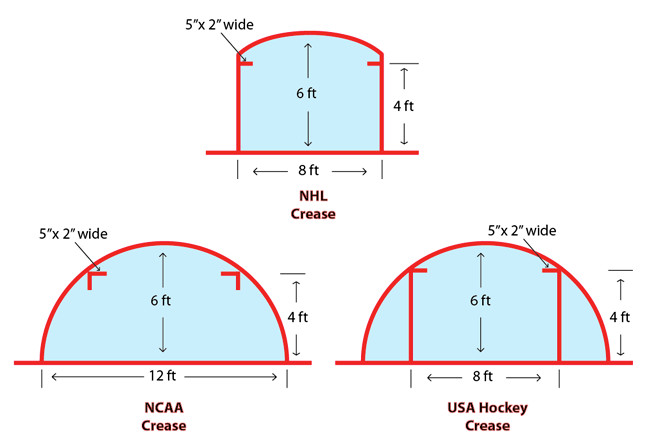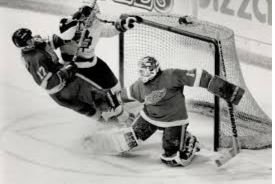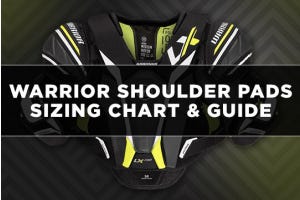Understanding the Crease in Ice Hockey

Start with a short introduction paragraph to set up what the rest of the article will cover.
In this article, the topic is the crease in hockey. How it got its name, how the rules have changed over the years, and the sole purpose for the crease. We start this article off by describing its main function and what exactly its used for.
In this article, we’ll cover:
- What is the Crease in Hockey?
- Where is the Crease in Hockey?
- What is the Purpose of the Crease in Hockey?
- Hockey Crease Rules
- Have Hockey Crease Rules Changed Over Time?
- Hockey Crease FAQs


What is the Crease in Hockey?
The crease in hockey is a goalies paradise. It extends frontward from the net and is painted blue for a skeptic of where the goalie needs to be positioned. He also cannot be touched in this area by opposing players, which will result in a penalty. The goalie lives in this area of the ice where his sole duty is to stop the puck.
Where Is the Crease in Hockey?
The crease extends 8 feet wide across the net and 4.5 feet vertically. It is shaded blue so players know not to access the area without the puck, which can result in a penalty. In 2005 they extended a trapezoid behind the net for goalies to be able to play the puck and feed it to the defense or wingers for a quick break out. This has drastically changed the way the position is played. Goalies are forced to play the puck behind the net when nobody else is back to receive a dump in or lose play. The NHL set the standard that goalies need to be able to play the puck confidently behind their net as the game is progressively moving faster every year.


What is the Purpose of the Crease in Hockey?
The main reason the crease was invented was to protect the goalie from opposing players running into them. Over the years the crease has changed shapes and size due to the speed of the game increasing. They may also use this to judge where they stand for faceoffs, one timers, breakaways, and odd man rushes. Attackers on the opposing teams may not access the crease unless they have the puck or received a pass through the crease. It is an unspoken rule that if the goalie is touched in the crease by the other team, the goalie along with his squad will most likely try to start a fight with you.
Hockey Crease Rules
There are many rules involving the crease in hockey. Even some unwritten rules that involve major ego’s. A player on the opposing team may not stand still in the crease without the puck, this will result in an infraction. A player may not deliberately cover the puck in the crease, this will result in a penalty to both teams. However, if there is a scrum in the crease and the referee cannot visually see the puck, the referee may blow the play dead whenever the time arises. The goalie can use his stick to push attackers out of his crease but cannot trip or hook.
Have Hockey Crease Rules Changed Over Time?
In the past 100 years of this game we love it has transitioned into something the past couldn't fathom. From wooden sticks to completely hollow carbon fiber. From goalies not wearing masks to a complete helmet around the head. Straight stick blades to curved ones. Furthermore, the crease rules have had significant changes as well. Up to 1917 goalies were not able to drop down on the ice and cover the puck. In 1921 goalies were able to play the puck and pass up to the blue line. It took till 1931 to introduce goalie interference, an opposing player may not obstruct the goalies view or stance in the crease. Although, just five years later they changed the dimensions from 5x8 to 3x7. But in 1951 they again changed the size back to 4x8 and the goalies were once again able to play the puck if the opposing team tried to ice it. Then in 1961 goalies were not able to skate out past their own blue line, this would call for an infraction. It wasn't till the 90’s when they changed it to the shape we see today. In 99’ they revised a rule to implement a no harm, no foul, no video review standard. In the early 00’s they changed the specs on sizes of pads goalies can use and what we see today.
Hockey Crease FAQs
Who is allowed in the crease in hockey?
The goalie is the only player allowed in the crease, unless the puck has traveled into the blue paint. Which at anypoint any player from both sides may enter the crease to fight for the loose puck if the goalie does not maintain possession of the puck.
Are players allowed in the crease?
The only point in time where a player may enter the goalies crease is when the puck is in a playable position when the goalie does not have full control over the puck.
How far can a goalie come out of the crease?
The rules have changed significantly for goalies and the crease in the past hundred years. In todays game the goalie may have access of the puck anywhere from his blue line to goal line to make a pass or play. Behind the goal line is a trapezoid, where the goalie can make contact with the puck. When behind the goal line and outside of the trapezoid the goalie will be penalized for making contact with the puck.
Who is the only player that can go into the crease?
The only player that may have access to the crease is a player with full control of the puck. He may shoot, pass, or deflect a shot with his stick in the blue-painted area.
Why is it called the crease in hockey?
The crease originated in different games long before hockey came along. There were dug-out lines in lacrosse and cricket that would eventually get the name crease.
Can you be in the crease and score a goal?
Ultimately, yes you can. You may enter the crease at the same time the puck crosses over the red line into the blue paint. Thus, giving you the go-ahead to enter the crease and tuck the puck in the back of the net. However, you may not interfere with the goalie when he takes possession of the puck.
Can you hit the goalie out of the crease hockey?
This has been a grey area for some time in hockey. It is frowned upon to hit the goalie anytime anywhere. This will result in a penalty, even if the goaltender has possession of the hockey puck.
Is it still icing If the puck goes through the crease?
If the puck enters through the sides of the crease barely missing the net it is still considered icing. Most of the time when the puck is traveling through the crease on an icing the goaltender will have to play the puck to defend their net.
Shop Goalie Gear at Hockey Monkey
Overall, the crease has changed for the betterment of the game as speed, agility, and aggression have progressed. The way the game is played today advancements have been needed every step of the way for goalies to adapt to new rules and pace of play.









Login and Registration Form
or
Create an account